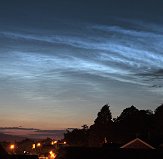| |
| |
Photographer,
Location |
Images |
Comments |
|

|
Martin Mc Kenna,
Maghera, Co. Derry, N. Ireland
Jun. 19, 2009 |
#1,
#2,
#3,
#4,
more |
Tonight was
the night when dreams came true for me as an NLC photographer.
A major display formed during evening twilight then I was
clouded out with showers. Between 01.00 and 02.00 BST the
sky cleared again and when I looked to the NW I saw the
NLC display of a life time. It looked like the end of the
world!. The shadow-casting structures which illuminated
the countryside were absolutely incredible. Large loops,
whirls and pillars with knots could be seen moving rapidly
in real time with the naked eye, these were astounding silver
and blue colours mixed with subtle yellow, gold and green
colours. It was a sight that left me awestruck. These are
4 images out of the 100 or so I took. Best NLC season I
have ever experienced! Fujifilm S6500fd various settings
|
|

|
Rob Powell,
Stonehaven, Kincardineshire, Scotland
Jun. 18, 2009 |
#1,
more |
EOS5D Mk2 250ASA 16-35mm@35mm 20s@f13
Lovely display over several hours during the night of 17th/18th June
|
|

|
David Storey,
The Isle of Man. UK
Jun. 18, 2009 |
#1,
#2 |
A very busy night with NLC's visible all night. Mainly in the north west but some NLC's in the north east by early morning. The intensity of the light from these clouds was very high. Electric blue and yellow clouds seen.
|
|

|
Rob Bullen,
Cinderford, Forest of Dean, Gloucestershire, UK
Jun. 17, 2009 |
#1,
#2, #3,
#4 |
Fantastic display, probably the brightest I have ever seen. Wonderful details seen throughout the display and easy to note changes in both brightness and its structure over a period of a few minutes. Looking forward to further displays this season. Panoramic photo is montage of all three individual images. Photo details - Canon EOS 40D, ISO 200 with a 17-44mm f4 lens set at f5 for 2.5 seconds exposure
|
|

|
Paul Evans,
Larne, Northern Ireland
Jun. 19, 2009 |
#1,
#2, #3,
#4, more |
Yet
another fabulous display of NLCs just after sunset here
in NI. This was almost as bright as last night's display
and was even better in carrying more detail in terms of
waves and ripples. This season is certainly living up to
expectations and proving the link with the solar minimum!
Pics taken with Sony DSLR-A100, Vivitar 28-200mm zoom, various
manual settings. Paul. |
more
images: from
Tomasz Adam of Staszów, Poland; from
John Grzinich of Ahja, Estonia; from
Gareth Pinckard on a transatlantic flight near Greenland;
from
Michał Nyklewicz of Poland; from
Rosenberg Robert of Fejér, Hungary; from
Monika Landy-Gyebnar of Veszprem, Hungary; from
Ákos Ujj of Bátonyterenye, Hungary; from
Eugene Eremchenko of Moscow Region, Russia; from
Andrew Thompson of Leeds, Yorkshire, England; from
Ava Ingren of Borth Village and beach, Wales, UK; from
Paul Smith of Haughton, Staffordshire, England; from
Dave Perks of Birmingham UK; from
Vladimir Knyaz of Moscow, Russia
|
|






